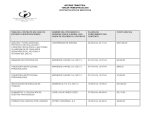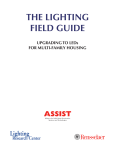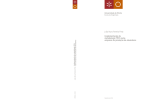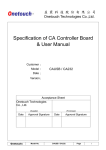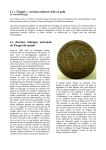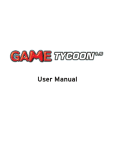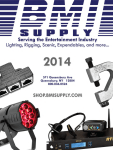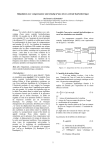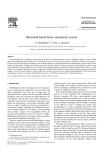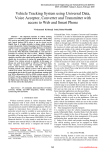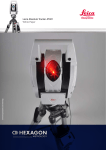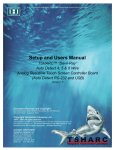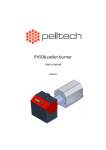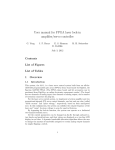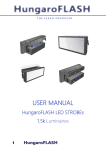Download Recommendations for Testing and Evaluating Luminaires
Transcript
recommends… Recommendations for Testing and Evaluating Luminaires for Refrigerated and Freezer Display Cases For upright refrigerator and freezer cases with vertically and horizontally mounted lamps Volume 5, Issue 1 November 2008 A publication of the Alliance for Solid-State Illumination Systems and Technologies recommends… Copyright © 2008 by the Alliance for Solid-State Illumination Systems and Technologies (ASSIST). Published by the Lighting Research Center, Rensselaer Polytechnic Institute, 21 Union St., Troy, New York, USA. Online at http://www.lrc.rpi.edu. All rights reserved. No part of this publication may be reproduced in any form, print, electronic, or otherwise, without the express permission of the Lighting Research Center. This ASSIST recommends was prepared by the Lighting Research Center at the request of the Alliance for Solid-State Illumination Systems and Technologies (ASSIST). The recommendations set forth here are developed by consensus of ASSIST sponsors and the Lighting Research Center. ASSIST and the Lighting Research Center may update these recommendations as new research, technologies, and methods become available. Check for new and updated ASSIST recommends documents at: http://www.lrc.rpi.edu/programs/solidstate/assist/recommends.asp ASSIST Sponsors Bridgelux China Solid State Lighting Alliance Cree Everlight Electronics Co., Ltd. Federal Aviation Administration GE Lumination ITRI, Industrial Technology Research Institute Lighting Science Group Lite-On NeoPac Lighting New York State Energy Research and Development Authority OSRAM SYLVANIA / OSRAM Opto Semiconductors Permlight Philips Lighting/Philips Solid-State Lighting Solutions Photonics Cluster (UK)/The Lighting Association Seoul Semiconductor United States Environmental Protection Agency USG WAC Lighting Lighting Research Center Technical Staff (in alphabetical order) Tianming Dong, Jean Paul Freyssinier, Nadarajah Narendran, Jennifer Taylor 2 recommends… Contents Introduction ................................................................................................................... 4 Background ................................................................................................................... 4 Proposed Method .......................................................................................................... 5 Room temperature (25°C) measurements ............................................................................................... 6 Photometric and electric measurements.............................................................................................. 6 Cold temperature measurements ............................................................................................................. 7 Light output scaling factor .................................................................................................................... 7 Display case power measurements ..................................................................................................... 8 Display case luminaire application efficacy calculation........................................................................ 9 CCT, CRI, and chromaticity ...................................................................................................................... 9 Measuring luminaire life............................................................................................................................ 9 Appendix A: Photometric Measurements ................................................................. 11 Selection of luminaire ............................................................................................................................. 11 Photometric measurements.................................................................................................................... 11 Testing conditions............................................................................................................................... 11 Appendix B: Test Setup for Near-field Photometry Measurements........................ 12 Appendix C: Sample Report Form ............................................................................. 15 Appendix D: Coefficient of Performance (COP) ....................................................... 16 Appendix E: Estimating Luminaire Application Efficacy – Summary..................... 17 References................................................................................................................... 18 Acknowledgments....................................................................................................... 19 About ASSIST .............................................................................................................. 19 3 recommends… Introduction This document outlines a recommendation for testing and evaluating the photometric, electrical, and thermal performance of white light luminaires for upright refrigerator and freezer cases with vertically and horizontally mounted lamps. This testing recommendation is applicable to all light source technologies. This recommendation was developed by the Lighting Research Center (LRC) at Rensselaer Polytechnic Institute in collaboration with members of the Alliance for Solid-State Illumination Systems and Technologies (ASSIST). The intent of this document is to encourage common, consistent methods of testing and data presentation for ease of interpretation and comparison, which will assist refrigerated display case manufacturers and end users in selecting suitable luminaires for this application. The target audience for this document is refrigerated display case manufacturers and purchasers, luminaire manufacturers, electric utilities, state agencies, and standards-setting organizations. Background The IESNA Lighting Handbook (Rea 2000) defines a luminaire as “a device to produce, control, and distribute light. It is a complete lighting unit consisting of the following components: one or more lamps, optical devices designed to distribute the light, sockets to position and protect the lamps and to connect the lamps to a supply of electric power, and the mechanical components required to support or attach the luminaire.” Supermarkets commonly use lighted refrigerated and freezer display cases to store and display merchandise that requires refrigeration or freezing. There are many types of refrigerated and freezer display cases; however, the types considered in this document are upright single-door and multi-door cases with vertical lamps or horizontal lamps. In these types of cases, the luminaires are usually mounted vertically at the door mullions or horizontally on the top or bottom of the cases. These luminaires produce localized lighting on the displayed merchandise (i.e., task or accent lighting). Usually, for refrigerated display case lighting applications, 3 to 10 footcandles (fc) average on the vertical surface is recommended (Rea 2000). However, common practice shows much higher light levels, in the order of 50 fc to 300 fc and in certain cases, even higher (LRC 1994, 2006). One possible explanation for the higher light levels inside the display case is to counteract the veiling reflections sometimes seen on the glass doors when the ambient light level in the store is high. To avoid veiling reflections, the luminance of the merchandise has to be greater than the luminance of the objects reflected on the glass door. One way of accomplishing this objective is by increasing the illuminance on the merchandise. Therefore, depending on the ambient lighting in the space, the vertical illuminance on the merchandise may need to be higher or lower. Although past studies have shown that the ratio of inside-to-outside illuminance is about 1.6 in supermarket freezer display cases (LRC 1994), recent surveys show that a ratio of up to 4 to 1 may be desirable (LRC n.d.). Traditionally, refrigerated display cases use linear fluorescent lamps, but now white light-emitting diodes (LEDs) are often being used as the light source in these luminaires. Other less common systems use remote light sources and fiber optics to deliver illumination to the merchandise. Many performance specifications traditionally used in the lighting industry assume the performance 4 recommends… of the lamp (or lamp-ballast combination), tested under an ideal environment, as the performance of the complete luminaire. However, this assumption is not correct because light sources perform differently inside luminaires, and this performance changes depending on application conditions. Generally, the luminaire design (e.g., the optics used to transfer the flux from the source to the application, housing with proper thermal management, etc.) influences the overall light output, luminous efficacy, color, and life of the system. Ultimately, the amount of luminous flux exiting the luminaire within the optical beam that illuminates the task, the color of the light within the optical beam, and the system (lamp, ballast [or driver]) life when used in an application1 are the most useful performance characteristics for the end user. Further, to allow users to make meaningful comparisons between products, performance metrics developed for lighting applications must be technology-independent. With certain technologies, the amount of heat experienced by the light source and the ballast (or driver) affects the overall performance of the luminaire in terms of light output, color (appearance and rendering), lumen maintenance, lamp life, and ballast (or driver) life. To obtain realistic performance data for a luminaire, the test environment must mimic the actual environment where the luminaire would be used. And in order to understand the effect that heat has on luminaire performance, the operating temperature must be measured accurately. Certain temperature points within a light source or ballast are known to have a direct relationship with performance. However, often these temperature points are not accessible once the light source and ballast (or driver) are packaged into a luminaire. Therefore, accessible temperature points that correlate to those known points that affect performance must be identified by the manufacturer. Proposed Method In refrigerated display case lighting applications, the distance between the luminaire and the illumination task plane varies depending on the location of the face of the displayed merchandise. Typically, it is very small, in the range of 3 in. to 10 in. Therefore, it is not possible to make accurate illuminance predictions using traditional intensity distributions measured with far-field photometry methods. Thus, in this application, near-field photometry is more appropriate than traditional far-field photometry. Furthermore, near-field illuminance measurements can be used to derive the amount of luminous flux illuminating the task plane, a metric that is necessary to rate the energy efficiency of a luminaire. This is an important point because the luminous flux on the task plane is the most useful, not all the flux that exits the luminaire, and should be the only one accounted for in rating the efficacy of a luminaire. Finally, because the operating temperature of most light sources affects the light output, when determining the luminaire luminous efficacy one must consider only the light that is useful for lighting the task at the refrigerated display case operating temperature and the total power used by the luminaire and the refrigerator for removing the excess heat generated by the luminaire within the case. Luminaire luminous efficacy = Total lumens on the task ÷ Total power As stated, this method calls for calculating the luminous flux that reaches the task plane when the luminaire and refrigerated display case are at the intended cold 1 Although there are other failure mechanisms that can cause a luminaire to fail in application, only the lamp and ballast (or driver) failure is considered in this document. 5 recommends… operating temperature. The calculation method is based on illuminance measurements on a grid at a standard distance of 6 in. from the luminaire, which represents a common distance between the luminaire and the front of the shelf rack in a refrigerated display case (Hussmann Corporation 2007; Tyler Refrigeration 2007). The illuminance measurements on the grid provide useful information to purchasers of display cases and designers because they can estimate the final light levels and uniformity in the application. But because it is difficult to create a testing setup to take all the illuminance measurements at the cold temperature of the application, this method is divided in two main stages. First, the illuminance measurements are taken at a room ambient temperature of 25°C. Second, a correction factor is calculated for the light output at the actual cold operating temperature inside the display case from relative light output measurements at 25°C and at the actual application operating temperature. The correction factor is then applied to the illuminance measurements and the total light output illuminating the task plane (which is derived from these measurements) to obtain values representative of the actual operating conditions. The following steps and Appendix B provide details on how to set up the measurement grid. The method considers a test area of 60 in. by 60 in., which is the typical height of upright refrigerated display cases and the typical width of two doors. Multi-door configurations are very common in supermarkets and convenience stores and can be tested as well using this method. Most manufacturers now offer luminaires designed for two typical vertical mounting locations, namely center mullions and end caps. The method described below considers testing one luminaire type at a time (either center mounted or end cap), but it is possible to test different configurations as well. For example, the same procedure would apply to a test that includes a center-mounted and two end cap luminaires. If the test is performed for each luminaire type separately, then it is possible to estimate the final illuminance, uniformity, and efficacy values by simply adding up the corresponding contributions from each luminaire. In this method, the test area for a center-mounted luminaire is 30 in. wide to either side of the luminaire. Because of the very short distance from the luminaire to the test plane (6 in.), it is unlikely that luminaires will make a meaningful contribution to the light level beyond the 30 in. limit. If the luminaire is specifically designed to contribute illumination beyond this proposed area, the test should be performed with an extended area and should be properly documented in the test report. Room temperature (25°C) measurements Photometric and electric measurements Step 1: Attach a thermocouple to the lamp to measure the lamp temperature (Ts) per the manufacturer’s suggestions (e.g., the board temperature for LEDs or the cold spot bulb wall temperature for linear fluorescent lamps). Step 2: Turn the luminaire on for 100 hours for seasoning the light source in the luminaire (or as recommended by the manufacturer or applicable standards when available). Step 3: Place the test setup in a room at 25°C ± 1°C ambient temperature with still air (air movement velocity less than 0.07 meter/second or 13 feet/minute; see Appendix A “Testing conditions: LED stabilization – preburning.”). Install the luminaire onto the mounting frame following the manufacturer’s recommendation. Appendix B provides details of the luminaire testing setup for near-field photometry and how to layout the testing grid. 6 recommends… Step 4: Turn the luminaire on and allow it to operate for at least 90 minutes to stabilize the light output. The light output is considered stabilized when the differences in sequential readings are no greater than 0.5% with a minimum of three readings taken approximately 15 minutes apart; see Appendix A “Testing conditions: LED stabilization – preburning.” Monitor Ts to verify that it too has stabilized. Step 5: Place an illuminance meter at the center of each individual grid square and record the vertical illuminance, Ev, in units of footcandles (fc). Proper conversion factors need to be used in the following steps if the illuminance measurements are taken in units of lux. Repeat this procedure for all squares. Step 6: Record the luminaire electric quantities: voltage, current, active and apparent power, power factor, and total harmonic distortion. Step 7: Record the light source operating temperature Ts25°C. Step 8: Calculate the luminous flux (Ф25°C [lm]) reaching the display plane (60 in. by 60 in.): Ф25°C = Σ Evij × Aij ÷ (144 in2/ft2) where Evij is the vertical illuminance on an individual square in footcandles, and Aij is the area of one grid square (i.e., 36 in2). Proper conversion factors need to be used if the illuminance measurements are taken in units of lux. Step 9: Calculate the average vertical illuminance (fc) on the display plane: Evaverage 25°C = Σ Evij ÷ N where N is the number of illuminance measurements (i.e., the number of grid squares; N = 100). Other metrics of uniformity can be calculated as well; for example, maximum-to-average and maximum-to-minimum ratios. However, the illuminance measurements and the uniformity ratios may not be representative of the final system until the contribution from adjacent luminaires is taken into account and the correction factor R (see step 18) is applied. Step 10: Generate a test report with the data recorded in steps 1 through 9. A sample report is shown in Appendix C “Sample Report Form.” Cold temperature measurements Light output scaling factor Step 11: Place the luminaire in a testing freezer in the same position as used in the application. In the case of linear fluorescent lamps, when transporting the lamp from the measurement rack used in steps 1 through 9 to the testing freezer, keep the lamp in the same position and avoid shaking the lamp. Sudden changes in orientation of the lamp can cause the mercury to migrate, resulting in longer stabilization times when the lamp is operated again. Step 12: Place an illuminance photodetector (see Appendix A) at a distance of 1 ft. from the luminaire. The purpose of this step is to measure the relative light output from the luminaire in at least two temperature conditions. It is therefore very important to keep the relative position between the photodetector and the 7 recommends… luminaire constant. Mechanical means should be used to fix the photodetector and prevent unintended movement. Note: The spectral response of the photodetector may be temperaturedependent. Therefore, the photodetector needs to be characterized at the freezer operating temperature. In addition, condensation on the photodetector should be prevented. Step 13: Turn the luminaire on while the freezer is off. Allow the luminaire to operate for at least 90 minutes to stabilize the light output. The light output is considered stabilized when the differences in sequential readings are no greater than 0.5% with a minimum of three readings taken approximately 15 minutes apart; see Appendix A “Testing conditions: LED stabilization – preburning.” Monitor Ts to verify that it too has stabilized and is within ±1°C of Ts25°C. Because the luminaire is now operating inside an enclosed environment, the ambient temperature inside the freezer may be higher than the 25°C at which the illuminance measurements of step 5 were taken, thus causing Ts to be higher than Ts25°C. In this case, proper ventilation may be needed so that the target ±1°C of Ts25°C is achieved. Step 14: Measure the illuminance value (E1) with the photodetector placed 1 ft. from the luminaire. Record the light source operating temperature (Ts1) as in step 7. Step 15: Turn the freezer on and allow it to stabilize to the same temperature as in an actual application (in some cases, a minimum of 48 hours may be needed for lamp and freezer stabilization). Step 16: Measure the illuminance value (E2) with the photodetector placed 1 ft. from the luminaire and record the lamp temperature (Ts2) once again as in step 7. Step 17: Record the luminaire electric quantities: voltage, current, active and apparent power, power factor, and total harmonic distortion. Step 18: Calculate the ratio (R) between the illuminance at freezer case operating temperature (E2) and the illuminance at room temperature (E1): R = E2 ÷ E1 Step 19: Scale the luminous flux calculated at room temperature (Ф25°C, step 8) by the ratio R. The resulting value is the application luminous flux, given by Фapplication = Ф25°C × R Display case power measurements Step 20: Monitor the average input power to the freezer in two conditions: a. Luminaire OFF (baseline; POFF) b. Luminaire ON (PON) Step 21: Both measurements should be taken after the freezer temperature stabilizes (in some cases, a minimum of 48 hours may be needed for temperature stabilization). Step 22: Measure input power (PL1) to the luminaire at room operating temperature (see step 17). 8 recommends… Step 23: Measure input power (PL2) to the luminaire at freezer operating temperature. Step 24: To calculate the excess power used by the freezer for dissipating heat load due to the luminaire, subtract the freezer power with luminaire OFF (POFF) condition from the freezer power with luminaire ON (PON) condition: PFr = PON - POFF Step 25: Calculate the ratio of the input power to the luminaire to the extra power demanded by the freezer (PFR) (Rundquist et al. 1993): RFR = PL2 ÷ PFr Step 26: Compare the ratio calculated in step 25 with the coefficient of performance (COP) of the freezer, if the information is available from the manufacturer, to validate results (see Appendix D). Step 27: Calculate total power demanded by the lighting luminaire and the freezer to dissipate the luminaire’s thermal load: PTotal = PL2 + PFr Display case luminaire application efficacy calculation Step 26: Calculate the luminaire’s application efficacy using the following equation: Application Efficacy (AE) = Фapplication ÷ PTotal A summary of the above procedures leading to an estimate of luminaire application efficacy is provided in Appendix E. CCT, CRI, and chromaticity Presently, no testing method has been established for measuring the color properties of the beam of a refrigerator or freezer case lighting luminaire. Therefore, use the data provided by the white light source manufacturers for CCT, CRI, and CIE x,y values. Alternatively, an illuminance meter capable of measuring CIE x,y and CCT values can be used to measure these metrics at both room ambient temperature and at the application’s cold temperature. This alternative is particularly useful if any of the optical components (e.g., reflector, diffuser) of the luminaire changes the appearance of the light emitted by the lamps. Measuring luminaire life For life-testing refrigerator or freezer case luminaires, the luminaire must be mounted according to the manufacturer’s recommendation for installing the luminaire in the intended application. Thermocouples must be attached to the temperature measurement points identified by the manufacturer for monitoring the lamp and driver temperatures. Life testing must be carried out at refrigerator or freezer operating temperature. For life-testing LED luminaires, follow the procedures explained in ASSIST recommends…LED life for general lighting (ASSIST 2007). 9 recommends… Note: For long-life light sources, the luminaire life may be expressed as the ballast (or driver) life, as the ballast (or driver) components may have a shorter life than the light source. 10 recommends… Appendix A: Photometric Measurements The procedures described below are taken from existing standards published by the Illuminating Engineering Society of North America (IESNA) and the Commission Internationale de l’Éclairage (CIE) and are to be used as further guidance to setting up and conducting the tests described in this document. Selection of luminaire Luminaires selected for test should be clean and representative of the manufacturer’s regular product. Ballasts (or drivers) regularly furnished as part of the luminaire should be used to operate the lamps during the test and should be mounted in their normal locations as to the lamps (IESNA LM-41-98, 1998). Photometric measurements Testing conditions Air movement. The luminaire (or test lamp during calibration) shall be tested in relatively still air. A maximum airflow of 0.07 meter/second (13 ft./minute) is suggested (IESNA LM-46-04, 2004). Lamp seasoning. Test lamps should be seasoned for a certain number of hours such that their characteristics remain constant during the test to be conducted (IESNA LM-54-99, 1999; IESNA LM-46-04, 2004). Luminaire stabilization – preburning. The luminaire requires a certain number of hours from start to allow the lamp and ballast (driver) to reach normal operating temperatures before starting the performance testing. Restarting of the lamp during the test should be avoided. However, if restarting is necessary, the test should be continued only when complete stabilization of the luminaire is again achieved. The lamp is considered stabilized when monitoring light output over a period of 30 minutes produces differences of sequential readings no greater than 0.5% with a minimum of three readings taken approximately 15 minutes apart (IESNA LM-41-98, 1998). Test voltage and current. The luminaire shall be operated at its rated voltage or current. If the rated voltage or current is a range, the center value shall be used as a test condition (IESNA LM-49-01, 2001). Instrumentation. Instruments shall be selected and used with care to ensure accurate measurements. Instruments should be calibrated a minimum of once a year. Instrument indications should have good reproducibility. The effect, if any, of instruments on measured quantities shall be addressed. See IESNA LM-2889, IES Guide for the Selection, Care and Use of Electrical Instruments in the Photometric Laboratory (1989) for detailed information. Photodetectors. Use photodetectors with a spectral response that follows the CIE spectral luminous efficiency (Vλ) curve (IESNA LM-41-98, 1998). In addition, it is important that the spatial sensitivity of the photodetector be cosine corrected. Because of the near-field conditions and the almost grazing angles between the luminaire and the end of the measuring task plane grid, special consideration needs to be taken to ensure that the cosine correction is acceptable. Many laboratory-grade photodetectors have an average f2 value of 1% to 2% and a maximum relative error within 5% in the range of 65° to 85°. Commercial photodetectors can have low average f2 values but high relative errors at angles higher than 65°. 11 recommends… Appendix B: Test Setup for Near-field Photometry Measurements The objective is to create a luminaire test condition for near-field photometry that can keep the lamp and the ballast (or driver) at operating temperatures similar to what they would be in real-life applications for refrigerated and freezer display cases. Figures B1, B2, and B3 show the schematic of three proposed test setups, including the testing display plane, luminaire mounting frame, and measurement grid. The luminaire mounting positions are vertical center, vertical side, and horizontal top for Figures B1, B2, and B3, respectively. These are the three most common positions for luminaires installed in refrigerator or freezer cases. A 60 in. by 60 in. display plane should be created. The surface of the display plane should be made of or covered by a light-absorbing material, such as black cloth (e.g., duvetyn) or Edmund Optics flock paper2 to avoid light interference between the luminaire and the plane. Alternatively, the surface can be painted with a low reflectance matte black paint, such as Rosco TV Black # 05740.3 Draw a grid on the display plane, as shown in Figures B1, B2, and B3. The individual sections of the grid shall be square, and the squares shall be 6 in. by 6 in. Mount the test luminaire onto an L-shaped mounting frame per the manufacturer’s recommendation for mounting the luminaire in the application. If the luminaire is mounted vertically, the center of the luminaire should coincide with the center line of the display plane. If the luminaire is mounted horizontally, the luminaire should be kept at the same height as the top edge of the display plane. Illuminance measurements should be taken with the test luminaire positioned 6 in. away from the display plane, which represents a common distance between the luminaire and the front of a shelf rack in a refrigerated display case (Hussmann Corporation 2007; Tyler Refrigeration 2007). It is also important to reduce the contribution from extraneous lighting on the measurement surfaces. If the testing cannot be performed in a dark room, block any ambient and reflected light with light-absorbing material around the testing planes. 2 3 Available from http://www.edmundoptics.com/onlinecatalog/displayproduct.cfm?productID=1502&search=1 Available from http://www.rosco.com/us/scenic/tv_paint.asp 12 recommends… Figure B1. Perspective and plan views of the luminaire test setup – vertical center mounting. Luminaire, positioned 6 in. away from the display plane Display Plane, 60 in. by 60 in. Luminaire mounting frame Measurement grid, 6 in. by 6 in. Driver or ballast Figure B2. Perspective and plan views of the luminaire test setup – vertical side mounting. Luminaire, positioned 6 in. away from the display plane Display Plane, 60 in. by 60 in. Luminaire mounting frame Measurement grid, 6 in. by 6 in. Driver or ballast 13 recommends… Figure B3. Perspective and plan views of the luminaire test setup – horizontal top mounting. Luminaire, positioned 6 in. away from the display plane Display Plane, 60 in. by 60 in. Luminaire mounting frame Measurement grid, 6 in. by 6 in. Driver or ballast 14 recommends… Appendix C: Sample Report Form 15 recommends… Appendix D: Coefficient of Performance (COP) In thermal engineering, the efficiency of a refrigerator is indicated by the coefficient of performance (COP), which is defined as follows (Cengel and Turner 2001): COP = Heat dissipation output ÷ Electric power input COP expresses how many units of heat can be removed per unit of electric power in steady state operation. However, COP is a function of temperature outside the refrigerator and temperature inside the refrigerator. The closer those two temperatures, the higher the COP. Simply, COP is a dimensionless ratio of output (cooling) to input (electric power). In the calculation of application efficacy (Step 26), COP is required to characterize the excess freezer power (PFr) to remove the heat generated by luminaires in the freezer. COP values may be available from freezer manufacturers. If the information is not provided, users can follow step 19 to step 24 to calculate the COP values, or use the typical values listed in Table D1 as an estimate. Table D1. Typical COP values for different refrigeration applications and temperatures. Application Temperature Range (Westphalen et al. 1996) COP (Cengel and Turner 2001) Preparation rooms -4°C ~ 2°C (25°F ~ 35°F) 2.5 ~ 3.0 Deli, dairy, and produce -9°C ~ -4°C (15°F ~ 25°F) 2.3 ~ 2.6 Meats -12°C ~ -9°C (10°F ~ 15°F) 2.3 ~ 2.6 Frozen foods -32°C ~ -26°C (–25°F ~ –15°F) 1.2 ~ 1.5 Ice cream -37°C ~ -32°C (–35°F ~ –25°F) 1.0 ~ 1.2 Note: In Westphalen et al. 1996, Fahrenheit was used as the unit of temperature. 16 recommends… Appendix E: Estimating Luminaire Application Efficacy – Summary Application Lumens at Room Temperature (25°C) Attach thermocouple to the lamp per manufacturer’s recommendations. Mount the luminaire vertically (or horizontally) onto the test setup. Turn on the luminaire for 100 hours for seasoning. Before taking measurements, turn on the luminaire until the light output stabilizes (minimum 90 minutes). Measure vertical illuminances at the center of each grid square and record the luminaire operating temperature (Ts) and all electrical parameters. Calculate lumens on the task area (60 in. by 60 in.): Ф25°C = [Σ Eij × (Aij ÷ 144 in2/ft2)] where Aij is the individual square area (in2) and Eij is the illuminance within a grid square. Application Lumens at Freezer Case Temperature Place the luminaire inside a test freezer. Place an illuminance meter at a distance of 1ft. from the luminaire. Turn on the luminaire while the freezer is off. After stabilization, measure the illuminance value (E1) from the meter placed 1 ft. from the luminaire. Measure the luminaire operating temperature (Ts1), which should be within ± 1°C the Ts value measured at room temperature. Turn on the freezer and allow it to stabilize (a minimum of 48 hrs may be needed). Measure the illuminance value (E2) from the meter placed 1 ft. from the luminaire. Measure the corresponding lamp temperature (Ts2) and all electrical parameters. Calculate the ratio of the illuminance at freezer case operating temperature (E2) to the illuminance at room temperature (E1). R = (E2 ÷ E1) Calculate corrected application lumens at freezer operating temperature. Фapplication = Ф25°C × R Power Measurements Measure luminaire input power at room temperature (25°C). Monitor freezer input power while the luminaire is OFF. Measure luminaire input power at freezer operating temperature. Monitor freezer input power while the luminaire is ON. Calculate excess power used by the freezer for dissipating heat due to lighting. Calculate total system power (luminaire and freezer). PL1 PFr-OFF PL2 PFr-ON PFr = PFr-ON – PFr-OFF PTotal = PL2 + PFr Refrigerated/Freezer Case Lighting Luminaire Application Efficacy Calculate luminaire application efficacy. AE = Фapplication ÷ PTotal 17 recommends… References Alliance for Solid-State Illumination Systems and Technologies (ASSIST). 2007. ASSIST recommends…LED life for general lighting. Volume 1, Issues 1– 7. Troy, N.Y.: Lighting Research Center. Internet: http://www.lrc.rpi.edu/programs/solidstate/assist/recommends/ledlife.asp. Cengel, Y.A., and R.H. Turner. 2001. Fundamentals of Thermal-Fluid Sciences. New York: McGraw-Hill. Hussmann Corporation. 2007. Technical Data Sheet: Impact RLN. Bridgeton, MO. Illuminating Engineering Society of North America (IESNA). 1989. IES Guide for the Selection, Care and Use of Electrical Instruments in the Photometric Laboratory, IESNA LM-28-1989. New York: Illuminating Engineering Society of North America. Illuminating Engineering Society of North America (IESNA). 1998. Approved Method for Photometric Testing of Indoor Fluorescent Luminaires, IESNA LM-41-98. New York: Illuminating Engineering Society of North America. Illuminating Engineering Society of North America (IESNA). 1999. IESNA Guide to Lamp Seasoning, IESNA LM 54-99. New York: Illuminating Engineering Society of North America. Illuminating Engineering Society of North America (IESNA). 2001. Approved Method for Life Testing of Incandescent Filament Lamps, IESNA LM-4901. New York: Illuminating Engineering Society of North America. Illuminating Engineering Society of North America (IESNA). 2004. Approved Method for Photometric Testing of Indoor Luminaires Using High Intensity Discharge or Incandescent Filament Lamps, IESNA LM-46-04. New York: Illuminating Engineering Society of North America. Lighting Research Center (LRC). 1994. A&P Food Market, DELTA Portfolio Lighting Case Studies, Vol. 1 (1). Lighting Research Center (LRC). 2006. Field Test DELTA Snapshots: LED Lighting In Freezer Cases. Troy, N.Y.: Lighting Research Center. Lighting Research Center (LRC). n.d. Survey of local supermarkets, conducted May 2008. Data not published. Rea, M.S. (ed.) 2000. IESNA Lighting Handbook: Reference and Application, 9th ed. New York: Illuminating Engineering Society of North America. Rundquist, R.A., K.F. Johnson, and D.J. Aumann. 1993. Calculating lighting and HVAC interactions. Atlanta, GA: ASHRAE Journal. Tyler Refrigeration. 2007. Installation and Service Manual: Model No. N5FGNA, N5NGNA. Niles, MI: Tyler Refrigeration. Westphalen, D., R.A. Zogg, A.F. Varone, and M.A. Foran. 1996. Energy Savings Potential for Commercial Refrigeration Equipment. Final report prepared by Arthur D. Little, Inc., for the Building Equipment Division, Office of Building Technologies, U.S. Department of Energy. 18 recommends… Acknowledgments ASSIST and the Lighting Research Center would like to thank the following for their review and participation in the development of this publication: China Solid State Lighting Alliance and GE Lumination. About ASSIST ASSIST was established in 2002 by the Lighting Research Center at Rensselaer Polytechnic Institute to advance the effective use of energy-efficient solid-state lighting and speed its market acceptance. ASSIST’s goal is to identify and reduce major technical hurdles and help LED technology gain widespread use in lighting applications that can benefit from this rapidly advancing light source. 19



















